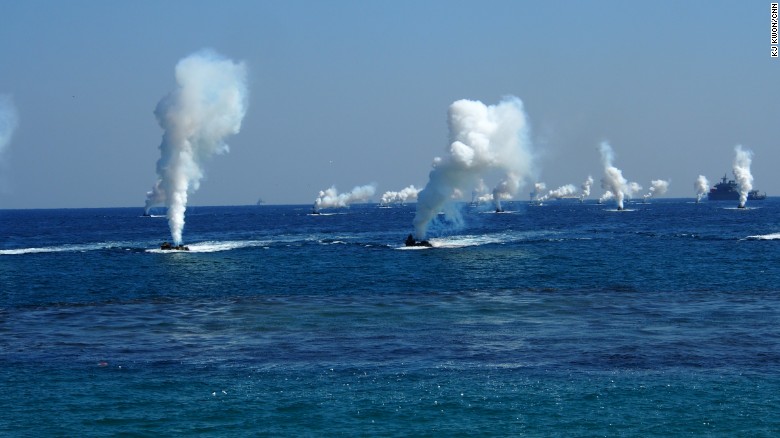Pohang, South Korea – Amid blasts of explosives and camouflaging smoke, U.S. and South Korean marines and sailors stormed a beach aboard assault vehicles Saturday in a mock amphibious landing.
The carefully choreographed drill begins a much larger, eight-week series of annual joint military exercises between the U.S. and South Korea.
They take place against a backdrop of growing tension and missile tests just across the Demilitarized Zone in North Korea.
South Korea’s defense ministry spokesman is calling the maneuvers “the largest scale ever,” involving 300,000 South Korean troops and at least 17,000 from the U.S.
Small detachments of forces from Australia and New Zealand also participated in Saturday’s operations.
Heightened tensions

The annual exercises have traditionally led to a ratcheting up of tensions with Seoul’s northern neighbor.
The last several months have been particularly contentious, after North Korea claimed to have tested its first hydrogen bomb and fired a satellite into orbit.
Both actions violate numerous United Nations Security Council resolutions. They led to a rare moment of unity on the Security Council earlier this month, when member states unanimously agreed to a new resolution punishing Pyongyang with additional sanctions.
Since then, North Korea continued to show its displeasure, firing short range projectiles off the peninsula’s eastern coast and revealing new weapons the regime claims to beminiaturized nuclear bombs.
‘Non provocative’
According to a U.S. military statement, the United Nations Command informed the Korean People’s Army in North Korea about the “non provocative nature” of this year’s joint military exercises.
But North Korea has responded with a threat of a “preemptive nuclear strike.”
“As the joint military exercises to be staged by the enemies are regarded as the most undisguised nuclear war drills aimed to infringe upon the sovereignty of the Democratic People’s Republic of Korea, its military counteraction will be more preemptive and offensive nuclear strike to cope with them,” Pyongyang’s state-run KCNA news agency announced on March 7th.
North Korea said Saturday the military exercises were “reckless” and its forces would “go over” the operation for preemptive retaliatory strikes at those involved in the drill, according to KCNA.
The U.S. general in charge of Saturday’s amphibious assault exercises insisted the drills were not related to the latest spike in tensions.
“We’ve been planning for this exercise for over a year,” said Brigadier General John Jansen of the U.S. Marines.
But, he added that the exercises should also serve as a deterrent to North Korea.
“At the end of the day, we sincerely believe in peace through strength, and it is in the strength of our alliance that we believe that we can deter and avoid war.”
Since an armistice was signed by warring parties bringing an end to the Korean War in 1953, the U.S. has kept tens of thousands of troops deployed in South Korea.
The U.S. mission, according to the U.S. Forces Korea webpage, is “to deter aggression and if necessary, defend the Republic of Korea (ROK) to maintain stability in Northeast Asia.”
Hundreds of Korean police officers were deployed around the beach and coastal villages where the military demonstration took place. They held back scores of flag-waving demonstrators.
Some of them traveled hours by car overnight to protest against the exercises.
“This drill is not defensive. It’s an act of war,” said Choi Eu Na, a member of a group that calls itself Anti-War Peace Action.
“I wish this aggressive stance, including that of North Korea, would stop hostile drills and start a peaceful atmosphere.”
In the early afternoon, a C-130 military plane disgorged troops in parachutes. They floated down onto a hillside cleared of foliage, within sight of rows of protester flags labeled “No War” and “Proceed with Peace Treaty.”
Though an armistice was signed more than 60 years ago, North and South Korea are still technically in a state of war.
As reported by CNN
